- Home
- THEORY – 理論(ものの考え方)
THEORY – 理論(ものの考え方)
私たちの地球の表面を覆っている土は、本質的に土粒子(固体)、水(液体)、空気(気体)から成る3相混合体である。水で飽和している飽和土であっても、土粒子(固体)と水(液体)から成る2相混合体である。全く異なる物質から成り立つ多相混合体は、人間にとって取り扱いにくい厄介な代物ではあるが、自然物であることもあって、“夢のある材料”であると思われる。
上記の土の本質的な構成に着目すれば、次のことに気付く。鉄やコンクリートとは違って、土は“育てる”ことができる。すなわち、子供を大人に“育てる”ように、土粒子の間の隙間(そこには水や空気がある)を狭めて固くし強くすることができる。このとき、あまり急激に大きな力をかけて土を破壊させないように注意しなければならない(子供に、いきなり重いリュックサックを担がせられないのと同じである)。
これらのことは、昔から“圧縮”あるいは“圧密”現象としてよく知られている。このような土の持つ素晴らしい特性を、人間はなぜもっと積極的に活用して来なかったのであろうか。“圧密”と聞くと、沈下が収まらない厄介な現象とイメージする人が多いからかもしれない。
研究会では詳しく説明しているが、ある載荷幅の“局所的な圧密”をさせるように段階的に載荷していくと、元の地盤の支持力の3倍程度まで短時間に“育成強化”できることが解析された。その“育成強化”された領域の内側に載荷幅を狭くして、さらに“局所的な圧密”をさせるように段階的に載荷すると、例えば元の地盤の支持力の8倍以上まで短時間に“育成強化”できることも解析されている。このような計算ができるようになったが、ソイルバッグ工法(D・BOX工法)は、すでに多くの田んぼや沼地のような軟弱地盤でこのことを実践している(理論計算は、いわば後付けをしているのである)。具体的にイメージしやすいように言えば、例えばN値が1の軟弱地盤をN値が3とか4の地盤に、必要に応じて“育てる”ことができるのである。これからは、N値=1の地盤は、未来永劫にN値=1であると考える必要はないのである。
次に、すでに明らかになっていることも含めて、ソイルバッグ(D・BOXを含む)の特性についてまとめてみる。
1.粒子間の摩擦で保持する土に対する最も有効かつ究極の補強法は、「土を完全に包み込み拘束すること」である(粒状体の区画拘束原理)。ソイルバッグはその典型的な適用例である。
2.ソイルバッグ自体が驚異的な耐力を発揮する力学的なメカニズムを解明し、耐圧力の2次元と3次元の表示式を誘導した。包み込み拘束するだけで、接着剤(セメント)を入れなくても、確実に粘着力cを付けることができる(ソイルバッグが強い本質的な理由はここにある)。ソイルバッグ1個が20~40tの荷重(JRの車両1~2台分)に耐えることができる。
3.砕石入りのソイルバッグは、袋の編み目がフィルターのように働いて水はよく通すが土粒子は通さない。この結果、水浸ヘドロ状態の軟弱な粘性土地盤であっても、水(水圧)をよく吸収し、ソイルバッグ直下から圧力球根状に局所的に圧密させて直下の地盤を速やかに育成強化し、地盤の支持力を増大させて沈下量を減少させる(ソイルバッグによる局所圧密・強化作用)。また、水をよく通して水圧を抜き、土粒子は通さないので、液状化対策にもなる。
4.ソイルバッグはわずかなしなやかさを有するので、交通振動や地震動のエネルギーを、目には見えない微少な袋の伸縮によって中詰め土の粒子間やソイルバッグ間の摩擦熱エネルギーとして消散させる。
5.砕石を入れたソイルバッグは、凍上防止効果もある。砕石粒子が大きいということは、粒子間の隙間も大きいので水が毛管上昇しない。従って、水の補給がないので凍上しない。
以上述べたように、一つの工法が5つの効果 ― 軟弱地盤対策・液状化対策・地震対策・交通振動対策・凍上対策としての効果 ― をもたらすソイルバッグ工法(D・BOX工法)のコストパフォーマンスの高さは注目に値する。まさに“一石五鳥”の工法である。なお、注意点としてソイルバッグ(D・BOX)の袋を日光(紫外線)にさらさないようにする(紫外線防止剤は入っているが)。土中に埋設すれば、袋の材質がポリエチレン、ポリプロピレンであるので、半永久的にもつ。
ノーベル生理学・医学賞の分野を見てみると、「もともと家畜用に開発された薬が人間にもよく効くことが分かった。世界中の多くの患者を助けた功績は極めて大きい。」というようなコメントを聞いたことがある。人体と同様、自然物である地盤の現象も複雑怪奇な面―特に振動問題や地震動問題―があって、全容が解明されるまで待つ必要はないと思う。今までの2,000件を優に超える施工事例を見ても、施工上の明らかなミスがない限りほぼ100%効くことが実証されている。原理は明らかにされており、実績はすでに十分であるので、どんどん用いていって、必要なら計測器による検査等によってその効果の程を確認すればよいと思う。あらかじめ結果を予測できる解析法や計算法がないと採用しないという設計者もおられるようであるが、もし世の中で用いられている解析法や計算法が完璧なものであれば、地盤に関する事故は起こらないはずである。土を透水性の袋で包み込んで拘束し締め上げるだけの本工法が、土の本質に根ざした本当に良いものであれば、しかるべき解析法が将来見いだされるものと期待する。
ソイルバッグ研究会代表 松岡 元
The soil covering the surface of our earth is essentially a three-phase mixture consisting of soil particles (solid), water (liquid) and air (gas). Even saturated soil saturated with water is a two-phase mixture consisting of soil particles (solid) and water (liquid). Polyphase mixtures which consist entirely of different substances are troublesome substitutes that are difficult for human beings to deal with, but because they are natural substances, they seem to be “dreamlike materials”.
Focusing on the essential constitution of the above-mentioned soil, it notices the following. Unlike iron and concrete, soil can “grow”. In other words, it is possible to narrow the gap between soil particles (there is water and air there) and strengthen soil, so as to “grow up” the child to an adult. At this time, care must be taken not to destroy the soil with too much sudden large force (it is the same as not being able to carry heavy backpack for children).
These things have long been well known as “compression” or “consolidation” phenomenon. Why did not human beings utilize such wonderful characteristics of soil more aggressively? It may be because many people imagine that “consolidation” is a troublesome phenomenon by which the ground subsidence does not stop.
It has been analyzed that the ground can be “grown and strengthened” in a short time to become to have about three times the bearing capacity of the original ground by gradually loading on the ground so as to cause “local consolidation” of a certain loading width on it. For example, it has also been analyzed that if loading is carried out step by step so as to narrow the loading width inside the “reinforcement strengthening” region and to make the “localized consolidation” further, the ground becomes to have 8 times or more the bearing capacity of the original ground in a short time.
Although this kind of analytical calculation became possible, the soilbag construction method (D・BOX construction method) has already practiced this with soft ground such as rice field and swamp (Analytical calculations are behind field performance.). For example, we can “nurture” the soft ground of N value=1 on the ground with N value=3 or 4. From now on, it is unnecessary for the ground with N value = 1 to consider keeping N value = 1 in the future.
Next, let’s summarize the characteristics of soilbags (including D・BOX).
1.The most effective and ultimate reinforcement method against soil retained by friction between particles is “to completely envelop and restrain soil” (principle of compartmentalization of granules). Soilbags are a typical example of their application.
2.The mechanical mechanism that the soilbag itself exhibits astonishing proof strength is clarified, and the two-dimensional and three-dimensional formulas of the strength of the soilbag itself are derived. Just by wrapping restraint, you can reliably apply cohesion c even without putting adhesive (cement) (here is the essential reason for the strong soilbag). One soilbag can withstand a load of 20 to 40 tons (one or two vehicles of JR).
3.In the soilbag with permeable materials such as crushed stones, the stitch of the bag acts like a filter, allowing water to pass well but not soil particles. Even if the soilbag is placed on a very soft clay ground in water, it absorbs water (water pressure) well, locally consolidates from just under the soilbag into a pressure bulb shape, and strengthens the very soft clay ground in a short time. As a result, the bearing capacity of the ground is increased and the settlement amount is decreased (local consolidation / strengthening action by the soilbag). In addition, as the soilbag passes water well, drains the water pressure, and it does not pass soil particles, it also becomes a measure against liquefaction during earthquake.
4.Since the soilbag has a slight suppleness, energy of the traffic vibration and the seismic motion is dissipated as friction heat energy between the particles of the filling soil and the soilbags, by a little expansion and contraction of the bag which is invisible to the eyes.
5.The soilbag with crushed stones has an effect of preventing freezing. The fact that the crushed stone particles are large means that the gaps between the particles are also large, so that water does not rise in capillary. Therefore, do not freeze because there is no water supply.
As mentioned above, the high cost performance of the soilbag construction method (D・BOX construction method) which brings out the effect of one method as five effects ― soft ground countermeasure, liquefaction countermeasure, earthquake countermeasure, traffic vibration countermeasure, and anti-freezing countermeasure deserves attention. It is exactly the method of “One Stone Five Birds”. In addition, as a precaution, do not expose the bag of soilbag (D・BOX) to sunlight (ultraviolet rays) (although it contains UV inhibitor). If buried in the soil, since the material of the bag is polyethylene or polypropylene, it has semi-permanent.
Looking at the field of Nobel’s physiology / medicine awards, I have heard such comments as follows: “It was found that medicines originally developed for livestock are also effective for human beings, and the achievement of helping many patients all over the world is extremely great.” Like the human body, the phenomenon of the ground which is a natural thing also has complicated strange aspects ― especially vibration problems and seismic motion problems. I think that it is not necessary to wait until the whole thing is elucidated. Even if we look at construction examples well above 2,000 so far, it has been proven that it is nearly 100% effective unless there is a clear mistake in construction. Since the principle is clarified and the achievement is already sufficient, I think that it is better to use it more and more and check the extent of its effect by inspection with suitable measuring instruments if necessary. There seems to be some designers who do not adopt it unless analytical method or calculation method which can predict the result beforehand is adopted, but if the analysis method and the calculation method used in the world are perfect, the accident concerning ground should not happen. If this construction method, which only encloses soil with a water-permeable bag and restrains and tightens up, is a really good thing rooted in the essence of soil, we expect that the appropriate analysis method will be found in the future.
Soilbag research group representative
Hajime MATSUOKA









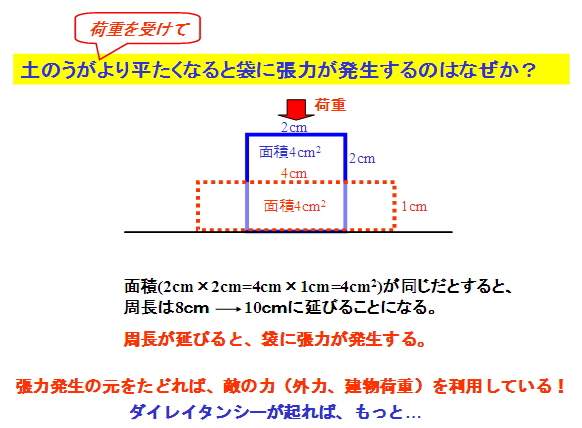
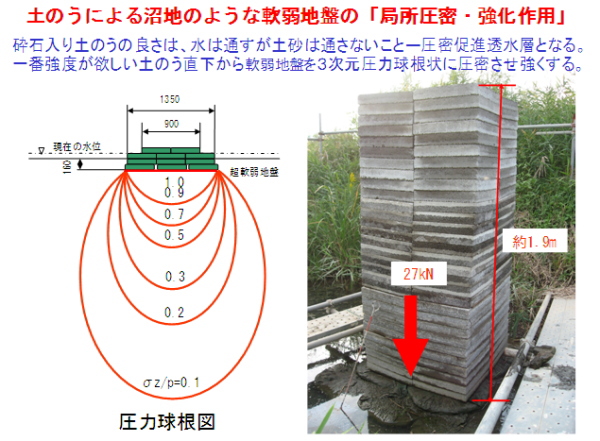
『土のう』の強さの秘密
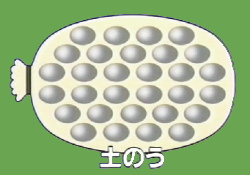
-
- 土のう袋に砂や砕石などを入れます。
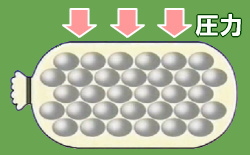
-
- 上から圧力がかかると、土のうは平らになります。
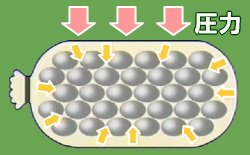
-
- 土のうが平らになると、袋の周囲の長さが延び、袋に張力が発生します。
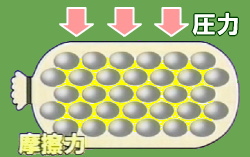
-
- 袋に張力が発生すると、袋の中の土粒子間の力が増加し、摩擦力も大きくなります。
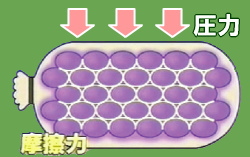
-
- 土粒子間の大きな摩擦力によって土のう全体が拘束強化し、コンクリート並みの強度を発揮するようになります。
【適用例】
●住宅基礎地盤の補強
●擁壁の裏込め材料
●各種公共事業
●補強土壁、擁壁などの基礎
●道路改修工事
●災害復旧工事
→事例についてはコチラ
■円形袋体の圧縮強度の評価方法
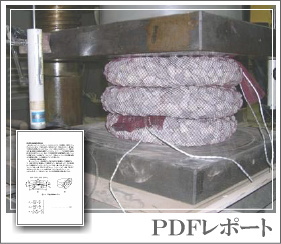 昔から用いられている「きんちゃく」からもわかるように、円形袋体は袋体がつり上げられたときに生じる、力学的に安定した自然な形であり、中詰め材に対して一様で極めて効果的な拘束効果を与えるものです。このような袋による拘束力によって、中詰め材は信じ難い驚異的な圧縮強度を発揮するようになります。そこで、ここでは円形袋体の圧縮強度の表示式を提示するとともに、砕石入りの円形網状袋体の圧縮試験結果と比較して十分な予測能力を持つことを検証します。これによって、「円形土のう」のような円形袋詰め補強土の圧縮強度を評価し、その性能表示をすることが可能となります。・・・
昔から用いられている「きんちゃく」からもわかるように、円形袋体は袋体がつり上げられたときに生じる、力学的に安定した自然な形であり、中詰め材に対して一様で極めて効果的な拘束効果を与えるものです。このような袋による拘束力によって、中詰め材は信じ難い驚異的な圧縮強度を発揮するようになります。そこで、ここでは円形袋体の圧縮強度の表示式を提示するとともに、砕石入りの円形網状袋体の圧縮試験結果と比較して十分な予測能力を持つことを検証します。これによって、「円形土のう」のような円形袋詰め補強土の圧縮強度を評価し、その性能表示をすることが可能となります。・・・
[続き(PDF)]
■土のうによる「局所圧密・強化作用」(沼地実験)
- 腰まで沈む沼地、深さ約3メートル
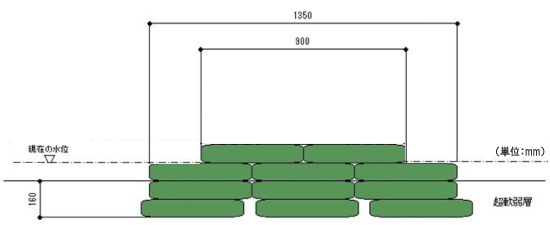
WHAT IS “SoilBAG”? – ソイルバッグ概要
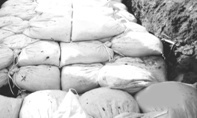 洪水などの災害時に活躍する『土のう』の最近の研究で、使い方次第ではセメント並みの強度を持つなど、これまでに知られていなかった長所が明らかになってきました。圧力に強い『土のう』の性質を発見したのは、名古屋工業大学の研究者たち。地盤工学が専門の松岡元(はじめ)教授のもと、土の粒子の研究に取り組む中で『土のう』が持つ強さに気付きました。
洪水などの災害時に活躍する『土のう』の最近の研究で、使い方次第ではセメント並みの強度を持つなど、これまでに知られていなかった長所が明らかになってきました。圧力に強い『土のう』の性質を発見したのは、名古屋工業大学の研究者たち。地盤工学が専門の松岡元(はじめ)教授のもと、土の粒子の研究に取り組む中で『土のう』が持つ強さに気付きました。
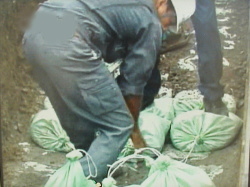 左はM県のマンション建設現場における作業風景です。通常は基礎を固めるためにセメントが用いられますが、この現場では『高規格土のう』が使われました。『土のう』は圧力がかかると固まるということが研究で明らかになり、品質についても信頼性の高さが実証されています。
左はM県のマンション建設現場における作業風景です。通常は基礎を固めるためにセメントが用いられますが、この現場では『高規格土のう』が使われました。『土のう』は圧力がかかると固まるということが研究で明らかになり、品質についても信頼性の高さが実証されています。
現場責任者は、土との相性が影響しやすいセメント系の固化剤と比べ、「間違いなく結果が出る、目的の品質が得られる」工法であると語っています。
 『土のう』の上から圧力をかけると、袋の内側に向けて力が働き、中の粒子が密着します。その結果、大きな摩擦力が生じ、まるでコンクリートのように固まるのです。固まった粒子は外には拡散しないので、よほど大きな力が掛からない限り、袋は破れません。
『土のう』の上から圧力をかけると、袋の内側に向けて力が働き、中の粒子が密着します。その結果、大きな摩擦力が生じ、まるでコンクリートのように固まるのです。固まった粒子は外には拡散しないので、よほど大きな力が掛からない限り、袋は破れません。
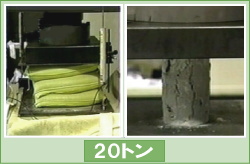 機械で実際に圧力をかけ、『土のう』の耐久力を実験してみます。右は、直径10センチのコンクリートです。上から同じ強さの圧力をかけています。圧力がおよそ20トンに達したところで、コンクリートには亀裂が生じていますが、『土のう』には変化がありません。
機械で実際に圧力をかけ、『土のう』の耐久力を実験してみます。右は、直径10センチのコンクリートです。上から同じ強さの圧力をかけています。圧力がおよそ20トンに達したところで、コンクリートには亀裂が生じていますが、『土のう』には変化がありません。
この実験では、37トンまで耐えることができました。
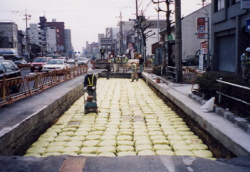 また、『土のう』には振動を吸収・遮断する効果が確認されています。『土のう』に鉛直荷重を加えた状態で繰り返し水平力を作用させた結果、振動がすぐに減衰されることが分かりました。ソイルバッグによる基礎補強は、このように高減衰構造体となるため、振動対策や地震対策として高く評価されています。こうした効果はすでに名古屋市内の幹線道路で活用されています。
また、『土のう』には振動を吸収・遮断する効果が確認されています。『土のう』に鉛直荷重を加えた状態で繰り返し水平力を作用させた結果、振動がすぐに減衰されることが分かりました。ソイルバッグによる基礎補強は、このように高減衰構造体となるため、振動対策や地震対策として高く評価されています。こうした効果はすでに名古屋市内の幹線道路で活用されています。
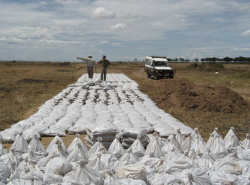 『土のう』にはどんな材質の土も入れることができるため、どこでも簡単に作り、工事に利用することが出来ます。東ティモールでの道路復旧工事や、ケニヤの道路建設などにも『高規格土のう』ソイルバッグが使われており、コンクリートなどの物資が不足した場所でも有効な資材として注目されています。
『土のう』にはどんな材質の土も入れることができるため、どこでも簡単に作り、工事に利用することが出来ます。東ティモールでの道路復旧工事や、ケニヤの道路建設などにも『高規格土のう』ソイルバッグが使われており、コンクリートなどの物資が不足した場所でも有効な資材として注目されています。
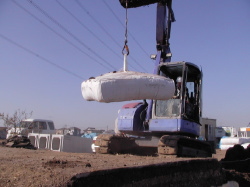 古くから身近にありながら、研究によって本格的な建築に利用されるようになった『土のう』が秘めた可能性は、まだまだあります。当研究会は、今後もこの『高規格土のう工法・ソイルバッグ』の研究と開発を続け、このすばらしい技術を通して社会に貢献していきたいと考えています。
古くから身近にありながら、研究によって本格的な建築に利用されるようになった『土のう』が秘めた可能性は、まだまだあります。当研究会は、今後もこの『高規格土のう工法・ソイルバッグ』の研究と開発を続け、このすばらしい技術を通して社会に貢献していきたいと考えています。











